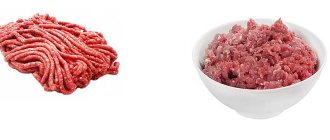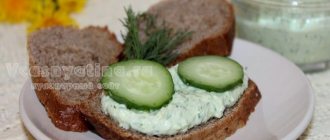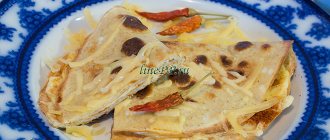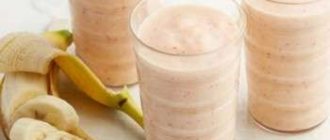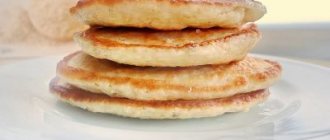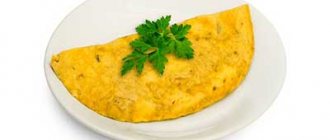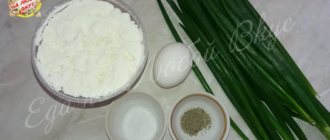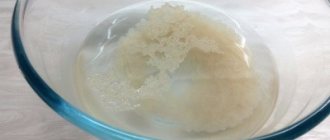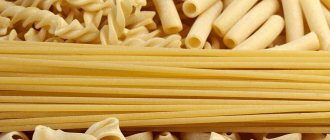12/16/2014 / Dairy products
| Homemade cheese, BJU and calorie content per 100 g of product | |||
| Calorie content 113 kcal | Proteins 12.7 g | Fat 5 g | Carbohydrates 4 g |
Homemade cheese is valued simply because it is made without preservatives or chemical additives. It is very useful for its nutrients. It cannot even be compared with those cheeses that are sold in stores. A person who makes cheese for his own consumption will not add harmful substances to it.
Making homemade cheese is very easy. Boil milk and make cottage cheese out of it. Then, using a special press, bring it to a solid state. It is best to use fresh milk. The lower the calorie content of the milk, the less caloric the cheese is. So for people who do not want to gain weight, you can use low-calorie milk. This is also a plus when making cheese at home, since the cheese maker himself regulates the fat content of the finished product.
Each person makes cheese to their own taste. Some people like to cook cheese with herbs, others add more salt. By adding sugar, you can get a sweet dessert cheese.
It is not recommended to buy low-quality cottage cheese in stores for further cheese preparation, since very often instead of cottage cheese they can sell a cottage cheese product, from which cheese obviously will not be made.
Properties of homemade cheese
Nutritional value and composition | Vitamins | Minerals
How much does homemade cheese cost (average price per 1 kg)?
Moscow and Moscow region.
400 rub.
From the name of homemade cheese, it immediately becomes clear what technologies are used in the manufacture of this product. Cheese producers are adopting home cooking recipes to expand the range of their products and meet the demands of a wider range of consumers.
We think it’s no secret that home-cooked meals have always been considered extremely tasty and healthy. People have been making homemade cheeses since time immemorial. Moreover, almost every housewife had her own recipe for homemade cheese. And only over time, manufacturers began to produce such cheese on an industrial scale.
Although it is unlikely that real homemade cheese can compare with store-bought cheese in its taste, aroma or consumer qualities. We invite you to take a closer look at homemade cheese. Firstly, cheese made at home will have excellent taste, nutritional and beneficial properties for the human body.
Secondly, you will receive a guaranteed quality product that will not contain preservatives, chemicals or flavoring additives, which unscrupulous manufacturers often add to cheeses. Thirdly, your own homemade cheese will cost much less than the store-bought equivalent.
And, perhaps, the most important quality of homemade cheese is that it contains all the useful elements, vitamins and organic compounds that milk contains. For example, just half a kilogram of homemade cheese will contain the same amount of protein, lactic fatty acids, vitamins, and other beneficial compounds as 4.5 liters of fresh cow's milk.
Many people are mistaken in believing that homemade cheese is difficult to make on their own. Yes, there are some specifics, but if you really want it, this won’t stop you from trying yourself as a cheese maker. To make cheese at home you will need fresh cow's milk.
In this case, the rule the more the better will work one hundred percent, because The amount of cheese directly depends on the amount of milk. The calorie content of homemade cheese also depends on the milk (from 113 Kcal per 100 grams) that you will use in making the product. The fattier the cow's milk, the higher the calorie content of homemade cheese.
The most delicious homemade cheese is made from fresh country milk, but if you don’t have the opportunity to find it, then full-fat cottage cheese is perfect. By the way, homemade curd cheese is made much faster than that made from milk. Usually homemade cheese belongs to the soft varieties, because For the production of hard cheeses, specific production equipment (press) is required.
What’s distinctive is that the future taste of homemade cheese depends only on you. When preparing, you can add to homemade cheese, in addition to salt, any other ingredients, spices, herbs or herbs, all at your discretion.
Application
Homemade cheese serves as an excellent snack, after which a person remains full for a long time. You can make different sandwiches with it, adding different ingredients to suit your taste. And homemade cream cheese can even be spread on bread.
Market Analytics
- Black Lives Matter movement: reaction and consequences for the beauty industry
- COVID-19 is changing the rules of the game in the cosmetics market
- Beauty of the future: cosmetic innovations 2021
Convenient search for beauty salons on our website
Beauty salons in Moscow Beauty salons in St. Petersburg Beauty salons in Ekaterinburg Beauty salons in Novosibirsk
Latest blog posts on our website
- Naturecream / Tremella Extract - Snow Mushroom Detox for Skin
- Prostye-sovety / How to visually enlarge your lips with makeup
- Naturecream / Apricot kernel oil for face
- Naturecream / MATRIXYL3000 - the best skin elasticity stimulator
- Naturecream / SPF in Natural Oils
- Naturecream / Geranium (Pelargonium) oil for skin health and beauty
- Prostye-sovety / Save on a beauty salon: procedures that can be done at home
- Naturecream / Growth Factor - brings back youth?
- Oksana-Lezina / 3 effective abdominal exercises from a fitness instructor for beginners
- Prostye-sovety / Making perfect curls at home
Latest forum topics on our website
- Natalya / How to properly make a gelatin mask?
- Mrs._Smith / Badly sunburned! What to do?((
- Ice / Is it necessary to combine fitness classes with a diet?
- Antonova / What can be used for hair loss?
- Radio operatorKat / Who was on a protein diet?
Other articles in this section
| Cottage cheese 0.3% The process of preparing cottage cheese 0.3%, including low-fat cottage cheese, is very simple. The milk is brought to the desired fat content, and then heated and curdled, separating into solid mass and curdled milk. The solid mass is squeezed out of excess moisture and natural cottage cheese is obtained. |
| Suzma This product is made from katyk. Suzma is very similar in appearance to ordinary cottage cheese, but its taste, smell, and consistency are very different from it. Suzma also has completely different properties. If a product such as cottage cheese can only be used to make cheese from it, then katyk can be made from suzma again. To do this, simply add serum. And if you add water, you can get ayran. At the same time, the beneficial qualities and freshness of the products will not change. Both cheese and butter can be made from this product. Therefore, we can say that Suzma combines the properties of many dairy products. |
| Cottage cheese 0.6% (low fat) Cottage cheese is a dairy product that is obtained by coagulating milk protein and then separating it from whey. After this process, milk protein becomes quite acceptable for the action of enzymes in the gastrointestinal tract. |
| Cottage cheese 0.2% Among fermented milk products, cottage cheese takes first place as the healthiest product. This is a protein food that is formed during the process of heating kefir and subsequent getting rid of excess liquid. |
| White mold cheese White mold cheese is a French delicate cheese with a layer of mold on the surface. This cheese is a soft variety, it has a creamy color and a uniform texture. The manufacturing technology of this type of cheese involves the thickening of milk, rennet and lactic acid bacteria. Next, the mass is fired or pressed. It is then treated with the white mold fungus Penicillium camemberti, which creates a white coating on the surface of the cheese. Cheeses ripen from two to seven weeks. |
| Cottage cheese 2% Cottage cheese 2% is low-fat cottage cheese, an environmentally friendly product, does not contain GMOs, chemical impurities, or harmful additives. The fat content of cottage cheese is determined depending on the fat content of the milk used. |
| Cottage cheese 0.1% Cottage cheese with a fat content of 0.1% is obtained by fermenting pre-skimmed milk. At the same time, it is not possible to completely remove all fats and therefore manufacturers indicate on curd packages the minimum amount of fat contained in cottage cheese. Currently, this product is considered the most popular among athletes and everyone who wants to lose weight. Low-fat cottage cheese tastes almost no different from regular cottage cheese, and at the same time contains almost the same amount of useful microelements and vitamins with a minimum calorie content. |
| Ryazhenka 6% In every product that a person makes from milk, you can find many minerals, vitamins, proteins and fats that are useful and necessary for the body. One of these is ryazhenka 6%. |
| Sour cream 10% (low-fat) Sour cream comes from milk. As you know, milk is the basis for many dairy and fermented milk products. To get sour cream, you need to skim the cream, add lactic acid bacteria, which cause fermentation processes, and leave the resulting mixture to brew. After some time, you will receive a tasty and healthy product, widely used and loved by many housewives. |
| Tilsiter Cheese Tilsiter Cheese is a semi-hard, round, flat cheese made from cow's milk, which has a unique, inimitable taste and smell of cumin and black pepper. The cheese has a yellow color, cracks, small holes and a brown crust. The birthplace of the cheese is the town of Tilser in East Prussia. Its recipe was invented by immigrants from the Swiss province of Bern. The production of cheese in large quantities for other countries only began in the 19th century. This species has won the special trust and love of gourmets. This is an excellent treat for raw foodists. |
Recipe Homemade cheese made from cottage cheese. Calorie, chemical composition and nutritional value.
Nutritional value and chemical composition of “Homemade cottage cheese.”
The table shows the nutritional content (calories, proteins, fats, carbohydrates, vitamins and minerals) per 100 grams of edible portion.
| Nutrient | Quantity | Norm** | % of the norm in 100 g | % of the norm in 100 kcal | 100% normal |
| Calorie content | 285.9 kcal | 1684 kcal | 17% | 5.9% | 589 g |
| Squirrels | 26.2 g | 76 g | 34.5% | 12.1% | 290 g |
| Fats | 17 g | 56 g | 30.4% | 10.6% | 329 g |
| Carbohydrates | 7 g | 219 g | 3.2% | 1.1% | 3129 g |
| Water | 48.5 g | 2273 g | 2.1% | 0.7% | 4687 g |
| Ash | 1.279 g | ~ | |||
| Vitamins | |||||
| Vitamin A, RE | 40.9 mcg | 900 mcg | 4.5% | 1.6% | 2200 g |
| Retinol | 0.039 mg | ~ | |||
| beta carotene | 0.009 mg | 5 mg | 0.2% | 0.1% | 55556 g |
| Vitamin B1, thiamine | 0.011 mg | 1.5 mg | 0.7% | 0.2% | 13636 g |
| Vitamin B2, riboflavin | 0.069 mg | 1.8 mg | 3.8% | 1.3% | 2609 g |
| Vitamin B4, choline | 39.48 mg | 500 mg | 7.9% | 2.8% | 1266 g |
| Vitamin B5, pantothenic | 0.204 mg | 5 mg | 4.1% | 1.4% | 2451 g |
| Vitamin B6, pyridoxine | 0.022 mg | 2 mg | 1.1% | 0.4% | 9091 g |
| Vitamin B9, folates | 1.101 mcg | 400 mcg | 0.3% | 0.1% | 36331 g |
| Vitamin B12, cobalamin | 0.082 mcg | 3 mcg | 2.7% | 0.9% | 3659 g |
| Vitamin D, calciferol | 0.346 mcg | 10 mcg | 3.5% | 1.2% | 2890 g |
| Vitamin E, alpha tocopherol, TE | 0.094 mg | 15 mg | 0.6% | 0.2% | 15957 g |
| Vitamin H, biotin | 3.178 mcg | 50 mcg | 6.4% | 2.2% | 1573 g |
| Vitamin RR, NE | 0.5663 mg | 20 mg | 2.8% | 1% | 3532 g |
| Niacin | 0.03 mg | ~ | |||
| Macronutrients | |||||
| Potassium, K | 22.12 mg | 2500 mg | 0.9% | 0.3% | 11302 g |
| Calcium, Ca | 12.79 mg | 1000 mg | 1.3% | 0.5% | 7819 g |
| Magnesium, Mg | 2.13 mg | 400 mg | 0.5% | 0.2% | 18779 g |
| Sodium, Na | 456.02 mg | 1300 mg | 35.1% | 12.3% | 285 g |
| Sera, S | 29.71 mg | 1000 mg | 3% | 1% | 3366 g |
| Phosphorus, P | 31 mg | 800 mg | 3.9% | 1.4% | 2581 g |
| Chlorine, Cl | 695.21 mg | 2300 mg | 30.2% | 10.6% | 331 g |
| Microelements | |||||
| Iron, Fe | 0.426 mg | 18 mg | 2.4% | 0.8% | 4225 g |
| Yod, I | 3.15 mcg | 150 mcg | 2.1% | 0.7% | 4762 g |
| Cobalt, Co | 1.742 mcg | 10 mcg | 17.4% | 6.1% | 574 g |
| Manganese, Mn | 0.0074 mg | 2 mg | 0.4% | 0.1% | 27027 g |
| Copper, Cu | 16.1 mcg | 1000 mcg | 1.6% | 0.6% | 6211 g |
| Molybdenum, Mo | 2.18 mcg | 70 mcg | 3.1% | 1.1% | 3211 g |
| Selenium, Se | 4.83 mcg | 55 mcg | 8.8% | 3.1% | 1139 g |
| Fluorine, F | 8.67 mcg | 4000 mcg | 0.2% | 0.1% | 46136 g |
| Chromium, Cr | 0.63 mcg | 50 mcg | 1.3% | 0.5% | 7937 g |
| Zinc, Zn | 0.1813 mg | 12 mg | 1.5% | 0.5% | 6619 g |
| Digestible carbohydrates | |||||
| Mono- and disaccharides (sugars) | 0.1 g | max 100 g | |||
| Essential amino acids | |||||
| Arginine* | 0.124 g | ~ | |||
| Valin | 0.121 g | ~ | |||
| Histidine* | 0.053 g | ~ | |||
| Isoleucine | 0.094 g | ~ | |||
| Leucine | 0.17 g | ~ | |||
| Lysine | 0.142 g | ~ | |||
| Methionine | 0.066 g | ~ | |||
| Methionine + Cysteine | 0.113 g | ~ | |||
| Threonine | 0.096 g | ~ | |||
| Tryptophan | 0.031 g | ~ | |||
| Phenylalanine | 0.102 g | ~ | |||
| Phenylalanine+Tyrosine | 0.178 g | ~ | |||
| Nonessential amino acids | |||||
| Alanin | 0.112 g | ~ | |||
| Aspartic acid | 0.193 g | ~ | |||
| Glycine | 0.066 g | ~ | |||
| Glutamic acid | 0.278 g | ~ | |||
| Proline | 0.063 g | ~ | |||
| Serin | 0.146 g | ~ | |||
| Tyrosine | 0.076 g | ~ | |||
| Cysteine | 0.046 g | ~ | |||
| Sterols (sterols) | |||||
| Cholesterol | 89.66 mg | max 300 mg | |||
| Saturated fatty acids | |||||
| Saturated fatty acids | 0.5 g | max 18.7 g | |||
| 14:0 Miristinovaya | 0.006 g | ~ | |||
| 15:0 Pentadecane | 0.002 g | ~ | |||
| 16:0 Palmitinaya | 0.322 g | ~ | |||
| 17:0 Margarine | 0.005 g | ~ | |||
| 18:0 Stearic | 0.138 g | ~ | |||
| 20:0 Arakhinovaya | 0.005 g | ~ | |||
| Monounsaturated fatty acids | 0.782 g | min 16.8 g | 4.7% | 1.6% | |
| 16:1 Palmitoleic | 0.061 g | ~ | |||
| 17:1 Heptadecene | 0.002 g | ~ | |||
| 18:1 Oleic (omega-9) | 0.643 g | ~ | |||
| 20:1 Gadoleic (omega-9) | 0.006 g | ~ | |||
| Polyunsaturated fatty acids | 0.198 g | from 11.2 to 20.6 g | 1.8% | 0.6% | |
| 18:2 Linolevaya | 0.173 g | ~ | |||
| 18:3 Linolenic | 0.009 g | ~ | |||
| 20:4 Arachidonic | 0.016 g | ~ | |||
| Omega-6 fatty acids | 0.3 g | from 4.7 to 16.8 g | 6.4% | 2.2% |
The energy value of homemade cottage cheese is 285.9 kcal.
Primary Source: Created in the application by the user. Read more.
** This table shows the average levels of vitamins and minerals for an adult. If you want to know the norms taking into account your gender, age and other factors, then use the “My Healthy Diet” application.
